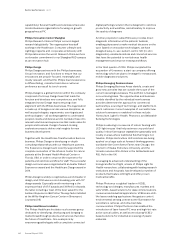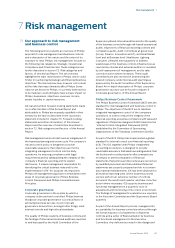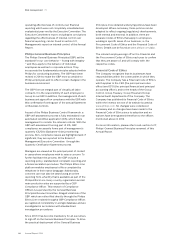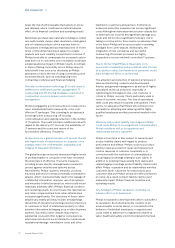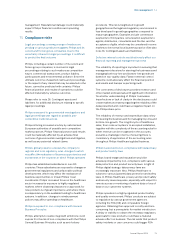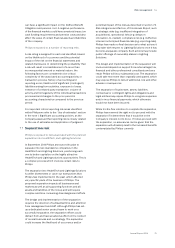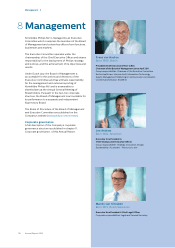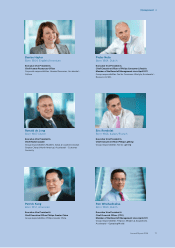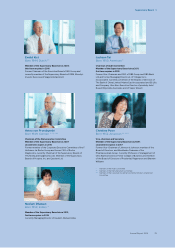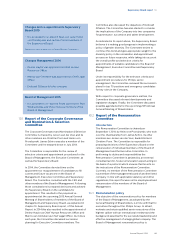Philips 2014 Annual Report Download - page 74
Download and view the complete annual report
Please find page 74 of the 2014 Philips annual report below. You can navigate through the pages in the report by either clicking on the pages listed below, or by using the keyword search tool below to find specific information within the annual report.Risk management 7.5
74 Annual Report 2014
business reviews which, if failed, could lead to business
interruption which in turn could adversely aect Philips’
nancial condition and operating results. E.g. the
voluntary, temporary suspension of new production at
our Healthcare facility in Cleveland, Ohio targets to
further strengthen manufacturing process controls after
certain issues in this area were identied during an
ongoing FDA inspection.
7.6 Financial risks
Philips is exposed to a variety of treasury risks and other
nancial risks including liquidity risk, currency risk,
interest rate risk, commodity price risk, credit risk,
country risk and other insurable risk.
Negative developments impacting the global liquidity
markets could aect the ability of Philips to raise or re-
nance debt in the capital markets or could lead to
signicant increases in the cost of such borrowing in the
future. If the markets expect a downgrade or
downgrades by the rating agencies or if such a
downgrade has actually taken place, it could increase
the cost of borrowing, reduce our potential investor
base and adversely aect our business.
Philips operates in approximately 100 countries and its
earnings are therefore inevitably exposed to
uctuations in exchange rates of foreign currencies
against the euro. Philips’ sales are sensitive in particular
to movements in the US dollar, Japanese yen and a
wide range of other currencies from developed and
emerging markets. However, Philips’ sourcing and
manufacturing spend is concentrated in the Eurozone,
United States and China. Therefore the net (revenues
less spend) sensitivity of Income from Operations to US
dollar and Chinese renminbi is relatively small. Income
from Operations is sensitive to movements in currencies
from countries where the Group has none or small
manufacturing/sourcing activity such as Japan and a
range of emerging markets such as Russia, Korea,
Indonesia, India and Brazil.
The credit risk of nancial and non-nancial
counterparties with outstanding payment obligations
creates exposures for Philips, particularly in relation to
accounts receivable with customers and liquid assets
and fair values of derivatives and insurance receivables
contracts with nancial counterparties. A default by
counterparties in such transactions can have a material
adverse eect on Philips’ nancial condition and
operating results.
Philips’ supply chain is exposed to uctuations in
energy and raw material prices. Commodities such as
oil are subject to volatile markets and signicant price
increases from time to time. If Philips is not able to
compensate for, or pass on, its increased costs to
customers, such price increases could have an adverse
impact on its nancial condition and operating results.
Philips is exposed to interest rate risk, particularly in
relation to its long-term debt position; this risk can take
the form of either fair value or cash ow risk. Failure to
eectively hedge this risk can impact Philips’ nancial
condition and operating results.
For further analysis, please refer to note 31, Details of
treasury / other nancial risks.
Philips is exposed to a number of dierent scal
uncertainties which could have a signicant impact on
local tax results.
Philips is exposed to a number of dierent tax
uncertainties which could result in double taxation,
penalties and interest payments. These include transfer
pricing uncertainties on internal cross-border deliveries
of goods and services, tax uncertainties related to
acquisitions and divestments, tax uncertainties related
to the use of tax credits and permanent establishments,
tax uncertainties due to losses carried forward and tax
credits carried forward and potential changes in tax law
that could result in higher tax expense and payments.
Those uncertainties may have a signicant impact on
local tax, results which in turn could adversely aect
Philips’ nancial condition and operating results.
The value of the losses carried forward is subject to
having sucient taxable income available within the
loss-carried-forward period, but also to having
sucient taxable income within the foreseeable future
in the case of losses carried forward with an indenite
carry-forward period. The ultimate realization of the
Company’s deferred tax assets, including tax losses and
credits carried forward, is dependent upon the
generation of future taxable income in the countries
where the temporary dierences, unused tax losses
and unused tax credits were incurred and during the
periods in which the deferred tax assets become
deductible. Additionally, in certain instances,
realization of such deferred tax assets is dependent
upon the successful execution of tax planning
strategies. Accordingly, there can be no absolute
assurance that all (net) tax losses and credits carried
forward will be realized.
For further details, please refer to the tax risks
paragraph in note 8, Income taxes.
Philips has dened-benet pension plans in a number
of countries. The funded status and the cost of
maintaining these plans are inuenced by movements
in nancial market and demographic developments,
creating volatility in Philips’ nancials.
A signicant proportion of employees in Europe and
North America is covered by dened-benet pension
plans. The accounting for dened-benet pension
plans requires management to make estimates on
discount rates, ination, longevity and expected rates
of compensation. Movements (e.g. due to the
movements of nancial markets) in these assumptions


